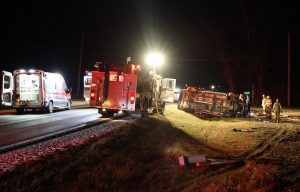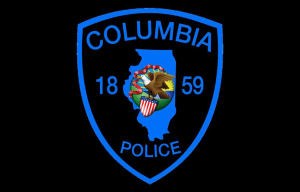History is tie that binds mounds effort, trails research
By COREY SAATHOFF and ALAN DOOLEY
For the Republic-Times
Two projects are working simultaneously to retrace the history of this region’s native peoples and first settlers in hopes of protecting their heritage and promoting their importance on the national stage.
The first project, spearheaded by a group of community leaders known as Heartlands Conservancy, aims to protect our region’s natural resources by expanding the inventory of ancient area Native American burial mound sites that may not currently be recognized.
A second project involves the Columbia Heritage Commission, Monroe County Genealogy Society, City of Columbia and City of Waterloo working together to complete an effort started nearly a century ago to mark the Kaskaskia-Cahokia Trails.
Mounds study
Citizens visited the Columbia Middle School library last Tuesday evening to see Heartlands Conservancy’s ongoing study of mound sites. The group is conducting a series of public meetings on both sides of the Mississippi River to bring its story to the public.
Seed money for this project included a $75,000 challenge grant from the Grand Victoria Foundation in Chicago. A major element in meeting the challenge came from the Oerter Foundation in Columbia.
Perhaps the most amazing indication of this group’s focus was a map of the entire bi-state region on display. The map marks the first time a comprehensive effort has been under- taken to locate the mounds that provide evidence of a once sprawling, vibrant civilization.
Around 1,000 A.D., when Europe was mired in the Dark Ages, the region stretching from northern Monroe County northward into St. Clair and Madison counties and mirrored across the river in Missouri was populated by tens of thou- sands of Native Americans.
They were organized in what were North America’s first cities.
Ed Weilbacher of Waterloo, who is helping the group on this project, said he was surprised during a visit to Mexico while touring the Chichen Itza Mayan ruins to be told by guides that Cahokia Mounds and the surrounding area are at least as significant to American prehistory as the re- mains of ancient civilizations in South and Central America.
Many who came to last week’s session were already familiar with the history of this civilization through what is now the Cahokia Mounds State Historic Site. But few were aware of its sprawling nature, as evidenced by the vast number of mound structures dotting the area.
Of local interest were maps with tiny symbols in the area from Dupo south to Columbia, both on the bluff and stretching to the river bottoms. The maps indicate existing mounds, others that are suspected and those that have been damaged or destroyed over time.
Heartlands Conservancy hopes eventually to be able to gain some type of national recognition for the region’s prehistoric resources and then leverage that into economic development based on tourism and visits to identified sites.
A trail — the Mounds Heritage Trail — is also being developed as part of this project to eventually enable hikers and bikers to travel among these several mound sites on both sides of the river.
For more information on this study, visit www.heartlandsConservacy.org or email the project’s team leader at mark. badasch@heartlandsconservancy.org.
Marking the trails
As the mounds provide evidence of this area’s original inhabitants, the history of the Kaskaskia-Cahokia Trail — from its beginning as buffalo traces and deer paths first used by the Native Americans and later French trappers to this area’s first roads — also bears importance.
The Monroe County Genealogy Society has, for many years, advocated the designation of the Kaskaskia-Cahokia Trail as a State and National Historic Landmark. The Lincoln Highway, Route 66, and the Lewis and Clark Trail already have such designations.
Columbia Heritage and Preservation Chairperson Dennis Patton, who conducted extensive research of the trails, learned that the first step for such designations should begin with the marking of the Old Trail through Monroe County.
Copies of his drafts of this research are available at Morrison-Talbott Library in Waterloo.
“Our goal is to improve local tourism and history,” Patton said.
He said large herds of bison marked the Kaskaskia-Cahokia Trace hundreds of years ago. Native Americans and French trappers used these paths for many years.
By 1725, these footpaths had been slowly widened into horse trails and rough cart and wagon roads. As American settlements grew, the dirt roads were widened through more frequent use.
The road from Kaskaskia to Cahokia was well established by 1812. Several inns and taverns could be found along the way, and a ferry across the Kaskaskia River benefited travelers. These early roads were basically dirt trails, but they saw considerable traffic, Patton said. They were further widened by men on horseback who followed the tracks.
Along these trails, pioneers felled trees, pulled stumps, and lowered grades by making cuts in the soil where needed. Their labor provided a relatively smooth and hard surface for horses and wagons.
Two trails connected Kaskaskia and Cahokia — the Upper Kaskaskia-Cahokia Trail and Lower Kaskaskia-Cahokia Trail. The Upper Trail wound its way from Kaskaskia to Prairie du Rocher, going through Renault, Burksville, Waterloo and Whiteside Station before descending the bluffs at Carr Creek west of Columbia and following the bluffs for six miles. The combined trail proceeded on to Dupo and Cahokia.
The Lower Trail left Kaskaskia via the same road as the Upper Trail. The Lower Trail, however, did not ascend the bluffs, but split off at Prairie du Rocher and veered north through the floodplain. The Lower Trail ran below the bluffs and passed east of the ruins of old Fort de Chartres before continuing on to the French village of St. Philip and on to Hull’s Town near Fults. It proceeded to Harrisonville before going on to old Valmeyer. From there, the trail passed Moredock Lake and north by Fountain. This trail continued north through the prairie in the bottoms before passing the Indian mounds near Bixby.
Four miles south of Cahokia, it joined the Upper Trail. The combined trails proceeded through Dupo, over the Prairie du Pont Creek, and into Cahokia.
When Waterloo and Columbia increased in population in the 1820’s, the Kaskaskia-Cahokia Upper Trail proceeded north from Bellefontaine along Waterloo’s Main Street, passed the Peterstown House, then past Whiteside Station and up Columbia’s Main Street.
In cars by the early 1900’s, as Patton puts it, “people could get around, so now they really wanted the roads improved.”
In 1913, the state proposed a plan for the improvement of its roads, most of which were still made of dirt. The St. Clair- Monroe Good Roads League was soon formed. The League reported that a survey revealed the most favored road name was Kaskaskia-Cahokia Trail. The name was used on future road maps.
In March 1917, concrete street signs could be purchased at one-fourth the cost of earlier metal ones, and they would last longer.
One of the plaster casts of this concrete sign is now stored at Peterstown House in Waterloo (see front photo above).






